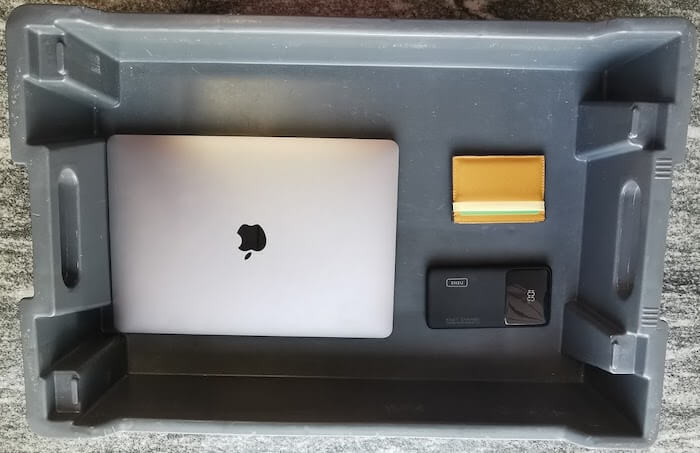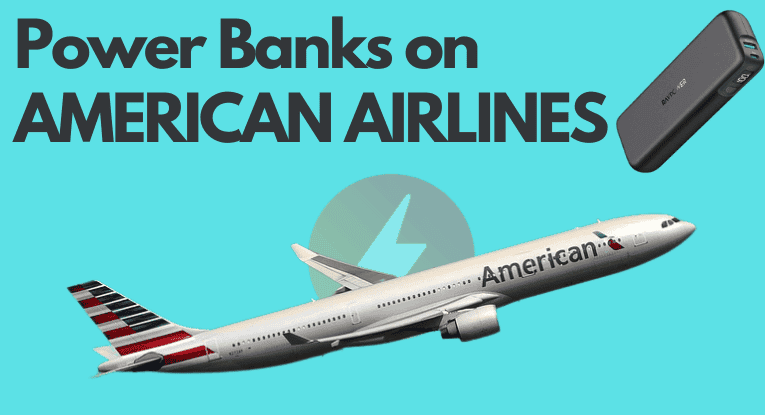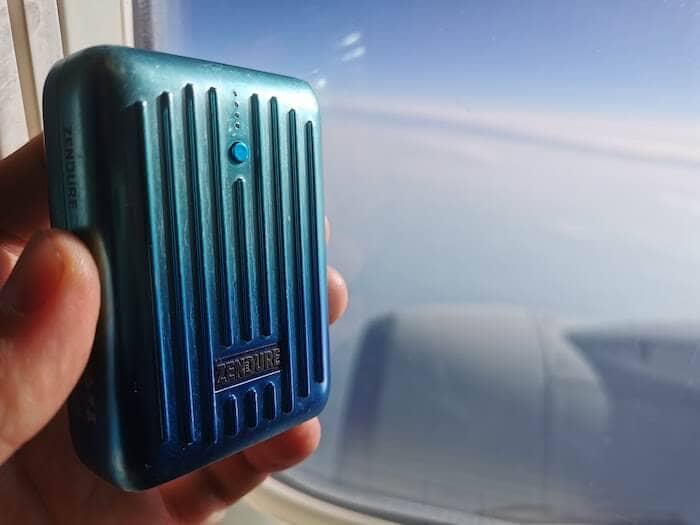Yes, you can take power banks on American Airlines flights, provided you take them in your carry-on and pack them in separate plastic bags. There are some restrictions when it comes to their capacity, however:
- <100 Wh – max 4 batteries
- 100 – 160 Wh – max 2 batteries
- 160 – 300 Wh – Contact Special Assistance
American Airlines treats portable chargers, battery packs, power banks, and mobile phone battery cases the same way it treats any type of lithium spare batteries, allowing them only in carry-on bags. For more information, you can read more info on this dedicated page on the official American Airlines website.
How to Find Out the Wh Capacity of Your Power Bank
A watt-hour (Wh) is a unit of measurement for the estimated energy consumption of electrical equipment for an hour. Most companies often print the Wh on the power bank, the product box, or the user manual.
On the other hand, some power banks and smart bags lack this information; in this case, visit our Wh calculator and provide the necessary data, including the mAh and Voltage of your power bank.
American Airlines’s Policy on Other Types of Rechargeable Batteries
General Purpose Batteries
American Airlines permitted passengers to bring 9-volt alkaline, AA/AAA/C/D, carbon-zinc, silver oxide, zinc-air, lithium or lithium-ion, nickel-cadmium, and nickel-metal hydride batteries. Remove batteries from gadgets before boarding the plane, place them in separate plastic bags, and bring them in your carry-on luggage.
In addition, you are permitted to bring four spare lithium batteries, each less than 100Wh, or two spare lithium batteries, each between 100 and 160Wh. If you have batteries with a capacity of between 160 and 300Wh, please contact American Airlines’ special assistance before buying the ticket.
Furthermore, American Airlines will let you carry a lithium metal battery if the lithium content is less than 2 grams per battery. Meanwhile, damaged batteries, including those from devices that have been recalled by manufacturers owing to battery defects, and any type of automobile, boat, or airplane battery are not permitted in carry-on or checked baggage.
Gadgets With Batteries
You are allowed to carry battery-operated gadgets onto the plane, including a watch, calculator, camera, cell phone, laptop, camcorder, iPod, and iPad. Notably, they allow up to two of each gadget and two spare batteries for personal use only. As a result, bags and boxes containing more than the specified number for personal use will be rejected.

Furthermore, if these devices are not intended for personal use, they are not allowed on board.
Drones
Drones are allowed as long as their battery does not exceed 160Wh. Also, the drones of the boxes they’re carried in need to be smaller than 22 x 14 x 9 inches / 56 x 36 x 23 centimeters.
Electronic Ciggarets / Vapes
They are allowed only in carry-on luggage, similar to the rest of the batteries. Their use during the flight is prohibited.
Hoverboards
Any type of battery-operated personal mobility devices such as hoverboards, balance wheels, or electrical scooters are not allowed on American Airlines flights.
Samsung Galaxy Note 7
American Airlines specifically mentions the fact that the Samsung Galaxy Note 7 is not allowed on their flights. They do not mention any other Samsung Galaxy model or any other brand. Just specifically the Samsung Galaxy Note 7.
Smart Luggage
You can take smart bags with you only if their battery is removable. Any smart luggage with non-removable batteries will not be accepted on board.
Damaged Batteries
Not allowed.
Automobile, Boat, or Aircraft Batteries
Not allowed.
Why are Airlines so Concerned With Batteries?
If something goes wrong with the gadget or battery, there is a strong possibility that it will overheat and catch fire. Therefore, it makes sense for passengers to carry them on board because if something goes wrong, it will be noticed instantly, and the crew can take proper action.
However, according to John Cox, a former pilot and CEO of Safety Operating Systems, an aviation consulting firm, “As we put lithium-ion batteries in cargo holds, they are no longer in an area where the crew can deal with them if they do catch fire. And the fire suppression systems using only [the common extinguishant] halon have not proven to be effective on lithium-ion fires.”
Since the past decade, incidents involving batteries have increased, and airlines have been attempting to control them. For instance, Fox News reported on January 6, 2019, that an E-cigarette battery ignited on an American Airlines aircraft. Even though no passengers or crew were hurt, it could lead to a major problem if carried in checked luggage.
Conclusion
Always check the airline’s regulations on their website before purchasing a ticket to ensure that you are permitted to carry specific devices on the flight. Bear in mind that violating the regulations might result in up to five years in jail and a $250,000 fine (49 U.S.C 5124).
If you’re interested in learning more about FAA and TSA rules related to portable chargers, check out this article: What types of power banks are allowed on a plane? 3 TSA rules you need to know.

